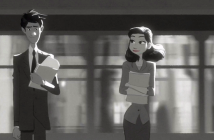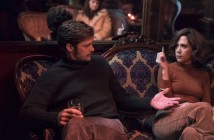Editor’s Note: The Man from U.N.C.L.E. opens in wide theatrical release tomorrow, August 14th.
While moviegoers wait patiently – if, in fact, they’re waiting at all – for entry number 24 in the long-running, not-so-recently reinvented Bond film, Spectre, they can take a moment (more like two full hours) to enjoy throwback visual and aural, if not narrative or thematic, pleasures of Guy Ritchie’s (RocknRolla, Revolver, Snatch, Lock, Stock and Two Smoking Barrels) latest foray into glib, slick Hollywood filmmaking, The Man from U.N.C.L.E., the big-budget adaptation of a semi-remembered, mid-‘60s TV property co-created by writer Ian Fleming (the same Ian Fleming who gave readers and moviegoers Bond, James Bond). But a catchy title – and it is, if nothing else, catchy – and some of the most eye-catching visual effects, up to and including the cast, and Daniel Pemberton’s ‘60s jazz-pop inflected score, do not an ersatz or faux-Bond make (e.g., Kingsmen: The Secret Service, Mission: Impossible I-V). Sometimes, however, that’s enough. Here, it’s not.
But a catchy title – and it is, if nothing else, catchy – and some of the most eye-catching visual effects, up to and including the cast, and Daniel Pemberton’s ‘60s jazz-pop inflected score, do not an ersatz or faux-Bond make.
Building (though building might not be the right word) on the thinly veiled homoerotic bromance of Ritchie’s last two films, Sherlock Holmes and Sherlock Holmes: Game of Shadows (a/k/a Steampunk Iron Man 1 and 2), The Man from U.N.C.L.E. centers on the fraught, conflict-ridden, potential life partnership between Napoleon Solo (Henry Cavill, DC’s Superman/Man of Steel), an unapologetic clotheshorse, unselfconscious womanizer, and occasional CIA agent, and Illya Kuryakin (Armie Hammer), an uptight, virginal KGB agent with serious rage issues. They’re meant to be two sides of the same masculine coin, circa 1960s (or at least pop-culture versions from that era). Both represent retrograde masculinity, one because he sees women as mere playthings and objects of desire, the other because he can’t get beyond treating women as possessions to control and manipulate. In Ritchie’s semi-dexterous hands, however, those objections rarely move to the foreground in The Man from U.N.C.L.E. thanks, in part to the retro cool stylings of Ritchie’s film.
 There’s the semblance of a plot too, of course, but it’s a plot cobbled together from other, better (and better-known) genre entries: Something about a super-secret villainous, fascist organization eager to start World War III (Nazis, ex- or otherwise, really are the worst), a loose nuke or two, an ex-Nazi German scientist responsible for said nukes, and the ex-Nazi German scientist’s daughter, Gaby Teller (Alicia Vikander), an East German auto mechanic Solo saves in The Man from U.N.C.L.E.’s opening scene/set piece from a Terminator-like Kuryakin. Before long, however, Solo and Kuryakin’s superiors in the CIA and the KGB force them to work together for the common good (i.e., the Cold War status quo). For seemingly bitter, ideologically driven rivals like Solo and Kuryakin, it’s enough to send them to a high-end clothing shop where they spar over Gaby’s new clothes. Key to finding her wayward father, Gaby makes contact with her Italy-based uncle, living the bourgeois high life as a business associate to The Man from U.N.C.L.E.’s central villainess, Victoria Vinciguerra (Elizabeth Debicki, The Great Gatsby), and her husband/sidekick, Alexander (Luca Calvani).
There’s the semblance of a plot too, of course, but it’s a plot cobbled together from other, better (and better-known) genre entries: Something about a super-secret villainous, fascist organization eager to start World War III (Nazis, ex- or otherwise, really are the worst), a loose nuke or two, an ex-Nazi German scientist responsible for said nukes, and the ex-Nazi German scientist’s daughter, Gaby Teller (Alicia Vikander), an East German auto mechanic Solo saves in The Man from U.N.C.L.E.’s opening scene/set piece from a Terminator-like Kuryakin. Before long, however, Solo and Kuryakin’s superiors in the CIA and the KGB force them to work together for the common good (i.e., the Cold War status quo). For seemingly bitter, ideologically driven rivals like Solo and Kuryakin, it’s enough to send them to a high-end clothing shop where they spar over Gaby’s new clothes. Key to finding her wayward father, Gaby makes contact with her Italy-based uncle, living the bourgeois high life as a business associate to The Man from U.N.C.L.E.’s central villainess, Victoria Vinciguerra (Elizabeth Debicki, The Great Gatsby), and her husband/sidekick, Alexander (Luca Calvani).
What little substance can be gleaned from The Man from U.N.C.L.E. revolves around Solo and Kuryakin’s relationship, but Ritchie and frequent collaborator Lionel Wigram can’t crack the hetero-bro code.
Following the overly familiar roadmap set up by ‘60s-era Bond films, The Man from U.N.C.L.E. departs a bifurcated Germany for Italy, but once in Italy The Man from U.N.C.L.E. never actually leaves, breaking one of Bond’s unspoken rules: Always globe trot to more than two or three locations. Not that Ritchie or his production team need to leave a sun-drenched, picture postcard-perfect Italy, of course. Ritchie found enough geographic and topographic diversity in Italy (not difficult, arguably) necessary for a film so dependent on visual pleasures like The Man from U.N.C.L.E. to keep moviegoers’ superficially engaged (if nothing else). Plot twists and turns follow with mechanical regularity, but anyone even tangentially or marginally familiar with Bond and Bond’s countless imitators can guess what they are. What really matters is what’s underneath all of the visual gloss Ritchie puts in front of his camera: Style first, second, and last.
What little substance can be gleaned from The Man from U.N.C.L.E. revolves around Solo and Kuryakin’s relationship, but Ritchie and frequent collaborator Lionel Wigram can’t crack the hetero-bro code they seemed to master with their iteration of Sherlock Holmes. Granted, Ritchie and Wigram had Robert Downey Jr. and Jude Law, actors with charisma and chemistry to burn, not to mention Downey Jr.’s hyped-up, hyperkinetic performance to keep things moving at a rapid-fire clip. Here, the combination of Cavill’s flattened American accent and a surface-deep character make Solo’s attempts at drollery fall repeatedly into yawn- or cringe-inducing territory. Hammer’s on-again, off-again Russian accent fares marginally better, but he’s stuck in a straight-man role minus a comic counterpart, leaving both actors to flounder at key narrative points.
The fault, of course, lies not in the stars (or their mythical, possibly non-existent star power), but in Ritchie and Wigram’s underwritten script. Spy-thrillers, played straight (no chaser) or played in parody or pastiche mode, require, at minimum, cleverly written and energetically delivered dialogue, character interactions with pop and menace (and occasional danger), a colorful, memorable villain(ess), and a handful of semi-inventive set pieces (The Man from U.N.C.L.E. has two, at most). As one example, they give Solo a potentially rich backstory straight out of Carol Reed and Orson Welles’ The Third Man (post-war career as a black marketer and art thief pressed into CIA service in exchange for a commuted prison sentence), but then do absolutely nothing with it. Despite Gaby’s role as plot device and marginal romantic interest (for Kuryakin), Vikander at least has more than one character trait or layer to play. That’s far from enough, however, to elevate The Man from U.N.C.L.E. above disposable, forgettable entertainment.
The Man from U.N.C.L.E. is all about style, first, second, and last. The little substance in the film revolves around Solo and Kuryakin’s relationship, but Guy Ritchie and frequent collaborator Lionel Wigram can’t crack the hetero-bro code they seemed to master with their iteration of Sherlock Holmes. The Man from U.N.C.L.E. is disposable, forgettable entertainment.



